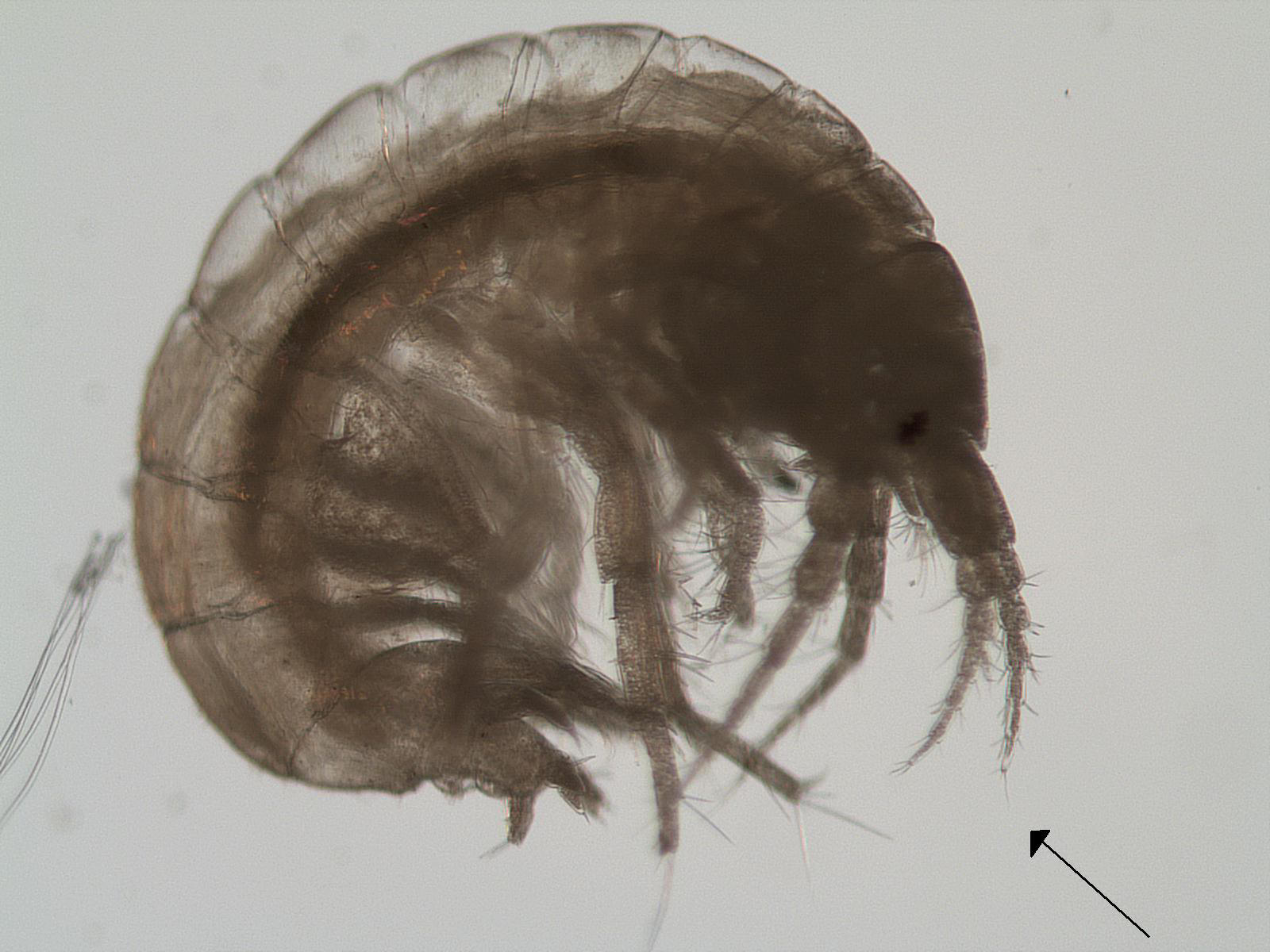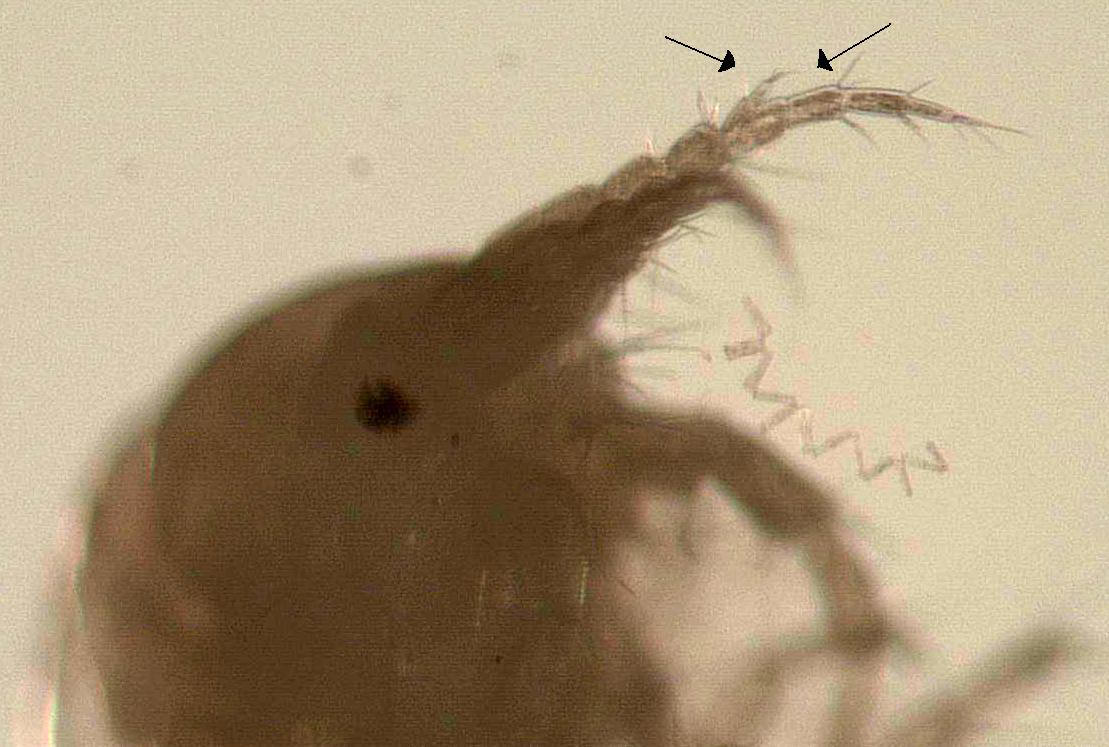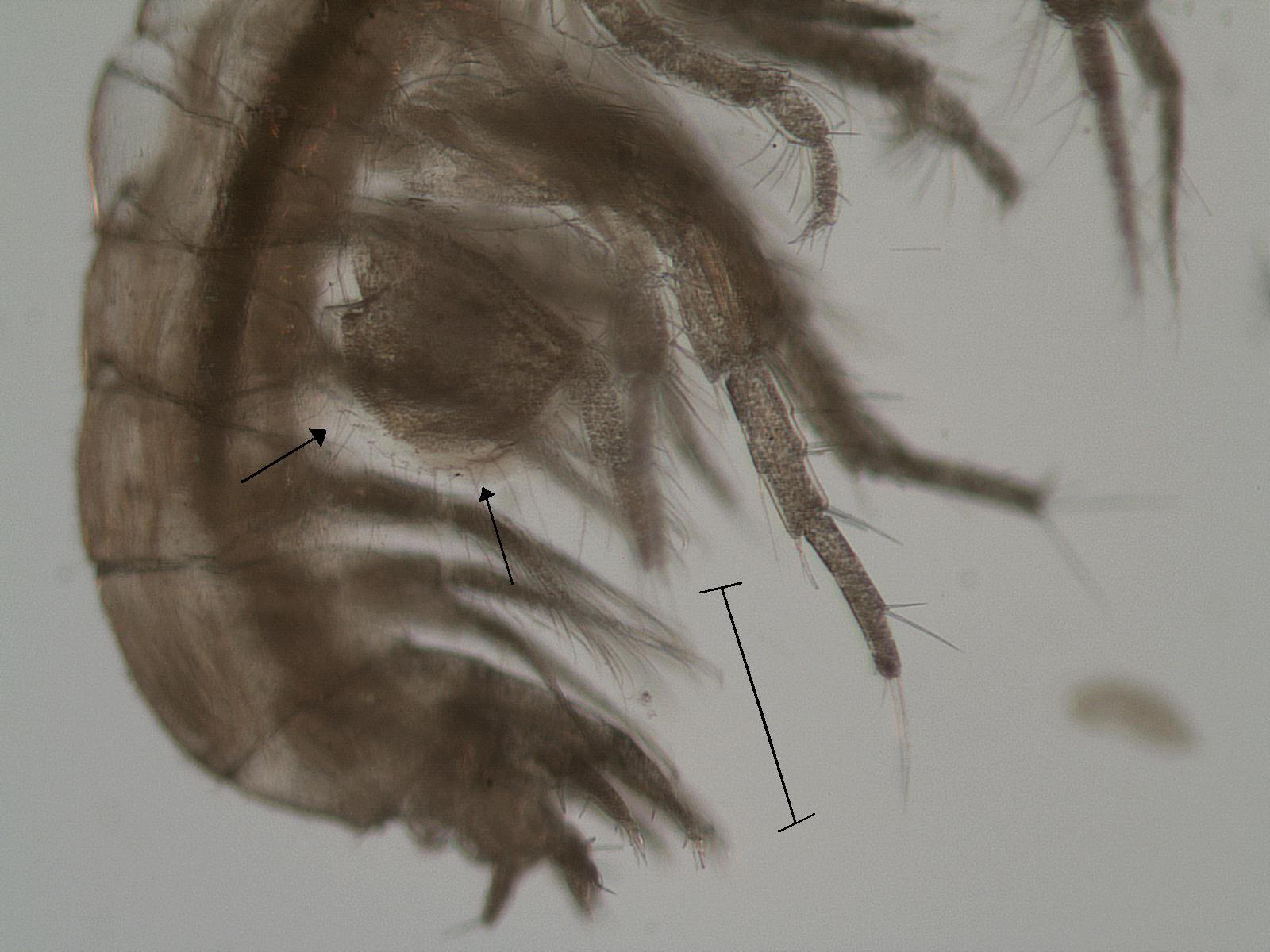|
Classification
Kingdom - Animalia Recent Taxonomic Revision All Diporeia spp. in the Great Lakes were previously classified as Pontoporeia hoyi (=P. affinis), although there are at least two different species of Diporeia, possibly eight, in the Great Lakes (Cavaletto et al. 1996). Taxonomic revisions were based on morphological characteristics and separated the Pontoporeia spp. in Europe from the Diporeia spp. in North America (Bousfield 1989). Specific characteristics that were used to separate the two genera include differences in the number of segments on the accessory flagellum, urosome 1 process (or lack of in Diporeia), uropod 3 terminal segment (or lack of in Diporeia), and other characteristcs (Bousfield 1989). Diporeia spp. are considered 'glacial relict' species with ancestors which lived in brackish waters and became trapped when the glacier receded (Siegfried 1985). Distribution Diporeia spp. are confined to the holarctic lakes of North America, which are summer-cold, continental, glacial relict lakes (Bousfield 1989). Diporeia spp. was found to be most abundant in the slope and profundal regions of the Great Lakes (Cavaletto et al. 1996), and the deep, cold regions of inland lakes (Seigfried 1985). Diporeia spp. was found in maximum abundance between depths of 30-50m in Lake Michigan (Nalepa et al. 2000) Habitat Diporeia spp. are widely distributed within the benthic region of the Great Lakes with little preference for substrate or organic matter (Marzolf 1965). They were found in substrate types of sand and silt with large amounts of organic matter in the top layer (<5mm) of the substrate (Marzolf 1965). Diporeia spp. may occur in the warm, slope, and profundal regions of Lake Michigan (Evans et al. 1990; Cavaletto et al. 1996), they are most abundant at the thermocline depth in the Great Lakes (Nalepa et al. 2000). Anatomy Diporeia has a laterally compressed body with 3 pairs of pleopods, 3 pairs of uropods, and two compound eyes (Figure 1). Mature females can vary from 6.0-9.0mm long (Balcer et al. 1984). Distinguishing characteristics of Diporeia spp. in the Great Lakes from other amphipods are the accessory flagellum, and the seventh periopod (Edmonson 1959). The accessory flagellum in located on the first antenna and is 3-4 segments in length (Figure 2) (Edmonson 1959). The second antennae is longer than the first (Edmonson 1959). Females have short first antenna (Figure 1) and mature males have very long first and second antennae (Edmonson 1959). The seventh periopod has an expanded second segment and is shorter than the sixth periopod (Figure 3) (Edmonson 1959). Feeding Diporeia spp. are detritivores preferring to feed on diatoms that settle out of the water column to the lake bottom (Cavaletto et al. 1996; Nalepa et al. 2000), however insect parts, chitin, dead rotifers, and ameoboid tests have been found in the guts of Diporeia (Evans et al. 1990). Diporeia have recently been declining in abundance in Lake Michigan, Lake Ontario, and Lake Erie(Pothoven et al. 2001; Dermott and Kerec 1997; Hoyle et al. 1999). The cause for this decline is hypothesized to be due to the establishment of zebra mussels (Dreissena polymorpha). Zebra mussels filter the water of the organic matter which would be food for Diporeia. This inability for Diporeia to receive the organic matter from the water column and increase in abundance has negative effects on the plantivores which depend on Diporeia as an important food source. Life History Diporeia spp. live from 1-3 yrs until the individual mates (male) or releases live young (female) (Siegfried 1985). In warm waters, Diporeia spp. is known to have a one year life cycle (Evans et al. 1990). Mating occurs in the winter and females carry eggs until they give birth in the spring (Evans et al. 1990). The young will grow rapidly and reach maturity by the following winter (Evans et al. 1990). Diporeia spp. have a two year life cycle in the slope region, with reproduction bouts occurring twice per year (summer and winter) (Evans et al. 1990). In the cold, profundal region, maturity occurs at 2.5-3yrs and reproduction bouts occur twice per year (Evans et al. 1990). The number of offspring produced is likely related to the size of the female (Balcer et al. 1984). |
Diporeia spp.  Figure 1. Female Diporeia spp. Notice the short first antenna. 
Figure 2. Located on the first antenna of a female Diporeia spp., the secondary flagellum has only 3-4 segments. 
Figure 3. The expanded seventh periopod. Notice the sixth periopod is longer in length. |
Works Cited Balcer, M., N. Korda, and S. Dodson. 1984. Zooplankton of the Great Lakes. University of Wisconsin Press, Madison WI. Bousfield, E.L. 1989. Revised morphological relationships within the amphipod genera Pontoporeia and Gammeracanthus and the "glacial relict" significance of their postglacial distributions. Can. J. Fish. Aquat. Sci. 46: 1714-1725. Cavaletto, J., T. Nalepa, R. Dermott, W. Gardner, M. Quigley, and G. Lang. 1996. Seasonal variation of lipid composition, weight, and length in juvenile Diporeia spp. (Amphipoda) from lakes Michigan and Ontario. Can. J. Fish. Aquat. Sci. 53: 2044-2051. Dermott, R. and D. Kerec. 1997. Changes in deepwater benthos of eastern Lake Erie since the invasion of Dreissena: 1979-93. Can. J. Fish. Aquat. Sci. 54: 922-930. Edmonson, W.T. (ed.). 1959. Fresh-water Biology, 2nd ed. John Wiley and Sons, New York. 1248p. Evans, M., M. Quigley, and J. Wojcik. 1990. Comparative ecology of Pontoporeia hoyi populations in southern Lake Michigan: the profundal region verses the slope and shelf regions. J. Great Lk. Res. 16: 27-40. Hoyle, J.A., T. Shaner, J.M. Casselman, and R. Dermott. 1999. Changes in lake whitefish (Coregonus clupeaformis) stocks in eastern Lake Ontario following Dreissena mussel invasion. Great Lk. Res. Rev. 4: 5-10. Marzolf, G.R. 1965. Substrate relations of the burrowing amphipod Pontoporeia affinis in Lake Michigan. Ecology 46: 579-592. Nalepa, T., D. Hartson, J. Buchanan, J. Cavaletto, G. Lang, and S. Lozano. 2000. Spatial variation in density, mean size, and physiological condition of the holarctic amphipod Diporeia spp. in Lake Michigan. Freshwater Biology 43: 107-119. Pothoven, S.A., T. Nalepa, P. Schneeberger, and S. Brandt. 2001. Changes in diet and body condition of lake whitefish in southern Lake Michigan associated with changes in benthos. North American Journal of Fisheries Management 21: 876-883. Siegfried, C. 1985. Life history, population dynamics, and production of Pontoporeia hoyi, (Crustacea, Amphipoda) in relation to trophic gradient of Lake George, New York. Hydrobiologia 122: 175-180.
|
